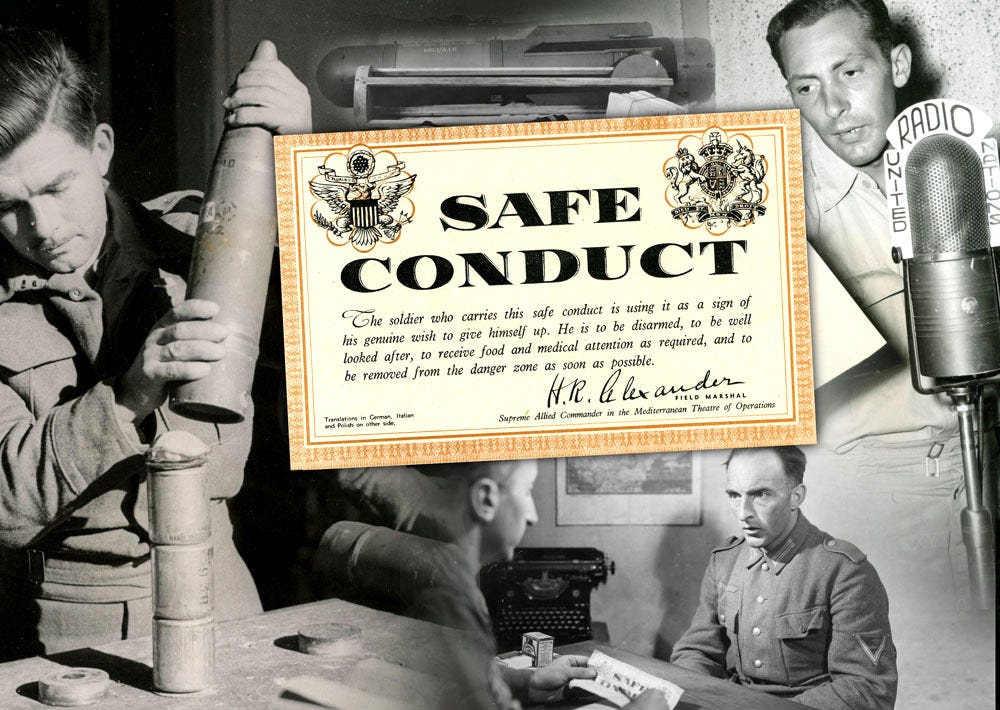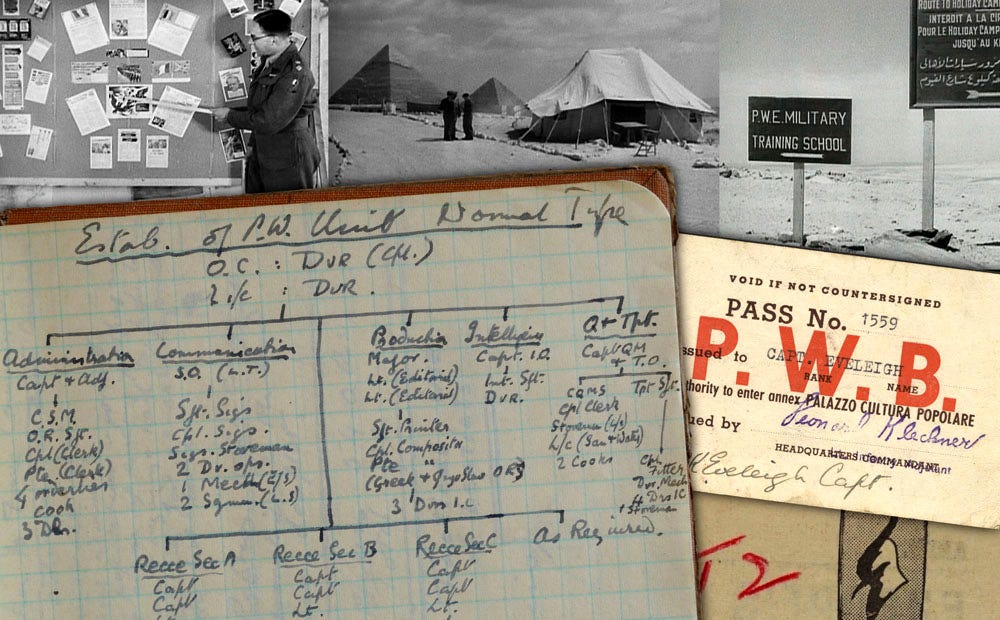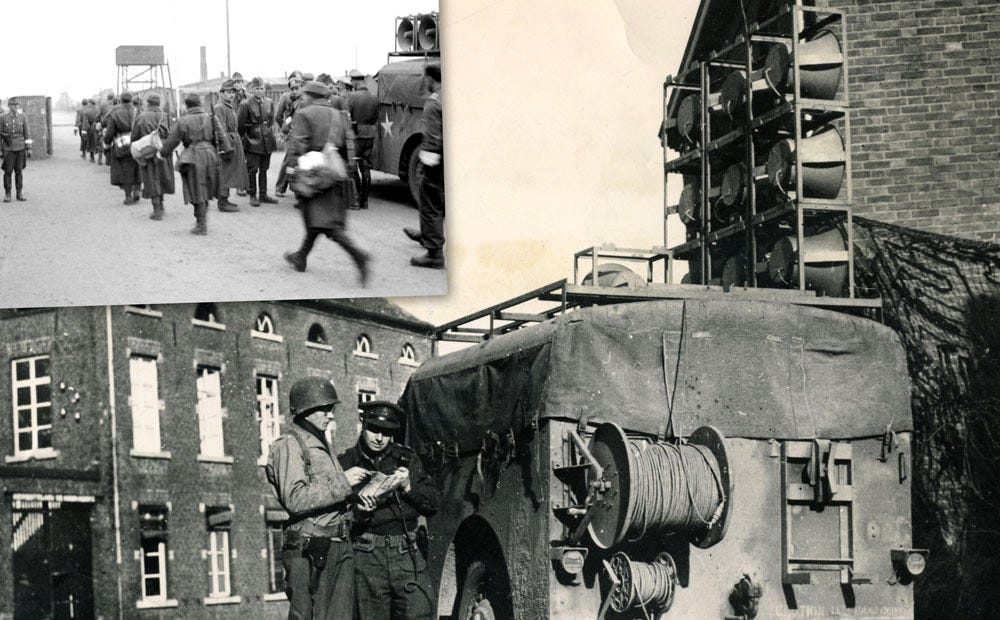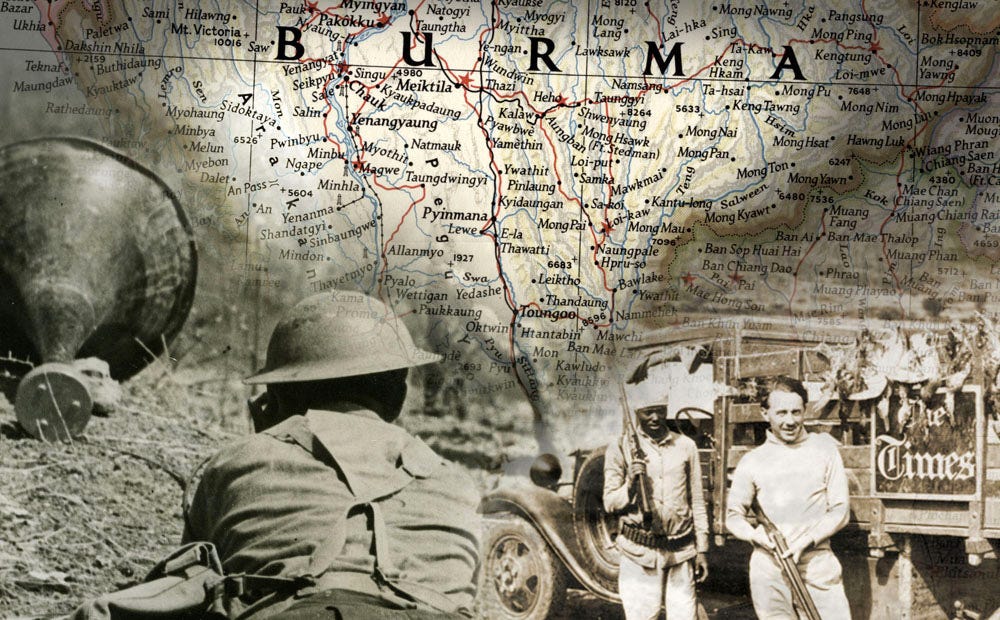British Army Political Warfare Field Units: An Overview by Lee Richards
A full record on the use of political/psychological warfare field units by the British Army is a conspicuous omission in the history of Political Warfare in the Second World War. A brief overview of the majority of those field units is attempted here, although due to the fragmentary nature of existing records it should be considered incomplete. Where available, further data in the way of nominal rolls and transcripts of war diaries will be added in the future.
1st Army Field Propaganda Company (North Africa)
The 1st Army Field Propaganda Company went into action with the Eighth Army in the Western Desert in June 1942. The Company consisted of four officers and 27 other ranks and had both a mobile radio broadcasting section and mobile printing section. Major N Smith, Royal Artillery, commanded the Company until September 1942 whereupon he took up a new appointment in Cairo. Thereafter Major Anthony Kenneth Milne, Intelligence Corps, was appointed Company O/C and remained so until its disbandment. Major Milne was a nephew of the famous author A A Milne, the creator of Winnie the Pooh and a former staff member of MI7 in the First World War.
The radio section consisted of a 450 watt shortwave transmitter. It produced and broadcast its own radio programme under the name ‘Radio Marmarica’. The station call sign was the Morse letter ‘V’ – dot-dot-dot-dash – sounded on a reed. Separate German and Italian programmes were transmitted on a wavelength of 35.33 metres up to five times a day. The programmes consisted of half entertainment and half news, talks and commentaries. General directives and propaganda material was provided by MO4 from Cairo and Jerusalem. Locally procured material, such as captured mail (addressed to Axis troops and undelivered), personal diaries, orders of the day, etc also provided useful content. Morse bulletins of Reuter’s and other news agencies were monitored to provide international news. Enemy broadcasts were also monitored to provide material for counter-propaganda. For entertainment large stocks of Italian and German gramophone records were available including complete acts from various operas which were put out in special Sunday broadcasts. The broadcasters included two Italian speaking officers, one Italian-speaking civilian and two German-speaking officers. The station’s initial target audience was Axis troops opposed to the Eighth Army. After Alamein special programmes were put out for Axis troops in Sicily and Southern Italy and others for those in the Balkans. The transmitter itself had to be located 200 miles away from the audience in order to be clearly audible. This did not present a problem when the situation was static but when the front became more fluid, difficulties were experienced communicating with forward areas to obtain local news for the broadcasts and subsequently had to be dropped from the programme. Reactions to the radio station through POW interrogation by CSDIC only provided one piece of evidence of listening. An Italian POW told an interrogating officer a story about an incident that occurred between German and Italians in Trieste, the story had been invented and put out by 1 Army Field Propaganda Company radio.
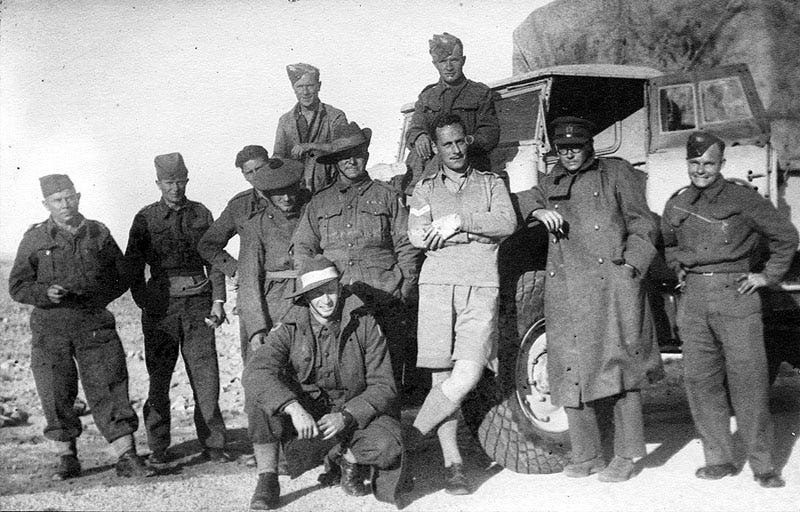
The mobile printing unit however was never used for its intended purpose of printing leaflets in the field for dissemination over the frontlines. This was entirely due to the lack of interest from the 8th Army Commander in propaganda work. Instead the mobile presses were used for the production of the Eighth Army News newssheet, reproducing General Montgomery’s famous personal messages to the troops and other PR work. The one leaflet the presses did produce is shown in the image above. 20,000 copies were printed at the beginning of November 1942 and was intended to be used after the breakout during the Second Battle of El Alamein. It is printed on one side in German with the same message repeated on the other side in Italian. It reads: “The 8th Army has broken through! Escape is futile! Surrender and you will be WELL TREATED. Otherwise you will be PURSUED relentlessly by the RAF and our tanks and be wiped out completely!” The leaflets were never disseminated.
The company remained active in the field until the end of June 1943. The Commanding Officer’s frustration at the diversion of the mobile printing section on to public relations work rather than being used for its intended purpose is clear. The number one point made in the Company’s lessons learned final report says: “What is undoubtedly the most important lesson is this: that you must sell propaganda as a weapon to the Army before you can hope to use it against the enemy.”
8th Army Combat Propaganda Team Psychological Warfare Branch (PWB/AFHQ)
For the planning of Operation Torch provision was made for a joint Anglo-American ‘Psychological Warfare Branch’ to conduct propaganda in the North African theatre. The Psychological Warfare Branch was formed from a mix of staff from the US Office of War Information and Office of Strategic Services and, on the British side, from PWE. Some served in uniform and others as civilians. US Colonel Hazeltine was appointed commander with Richard Crossman, later an eminent Labour Cabinet Minister, being the most senior British official attached. Before his transfer to the Middle East, Crossman was head of the German section of PWE.
The Psychological Warfare Branch provided the framework for the future organisation of tactical psychological warfare. It invented, or re-invented, new means of leaflet dissemination using artillery shells and dedicated leaflet bombs and developed staple leaflet products like Safe Conduct Passes and bomb warnings. It put captured radio transmitters back on air, monitored enemy broadcasts and also formed Combat Propaganda Teams. The 8th Army Combat Propaganda Team was under British command with the 5th Army Combat Propaganda Team under American command. Although there was an Anglo-American mix of personnel in both Teams. The branch attempted to measure effects of psychological warfare with a programme of enemy prisoners of war interrogations. As planning for Operation Overlord commenced, a new Psychological Warfare Division was formed under the command of General Robert McClure. The Psychological Warfare Division was not only fathered by PWB but also supplied it with most of its staff.
Political Warfare Forward Units (Central Mediterranean)
At the beginning of 1944 several more field units were created including the 814th and 815th Political Warfare Forward Units. The 814th spent most of 1944 training at the PWE depot and school outside Cairo, located on the Mena road, half a mile from the pyramids and also in Cyprus. It disappears in the direction of Greece in October 1944 and is reconstituted as AGIS (Anglo-Greek Information Service).
Originally designated as a Political Warfare “Z” Unit, the 815th was an entirely self-contained, wholly military mobile unit. Its War Establishment was based on the Phantom special reconnaissance units. Its sub-units were designed to be capable of independent action for a limited period. It was composed of 17 officers, some of which were parachute trained, and 54 other ranks. It was organised with a mobile headquarters and three Recce (or forward) Sections. It had its own radio communications and motorcycle despatch riders for maintaining contact between the mobile headquarters and the recce sections. The recce sections, which could advance up 30 or 40 miles, were intended for the interrogation of captured German troops and could operate loudspeaker equipment for broadcasting purposes. The HQ Wing included typesetting facilities and printing presses for the production of leaflets.
The 815th was sent to Italy but the personnel and its equipment were soon dispersed amongst other psychological warfare units being operated by the pre-existing Psychological Warfare Branch. One officer of the 815th did take part in a loudspeaker broadcast during the last battle of Cassino in mid-May 1944. The Public Address truck was parked up in the Cassino cemetery between two houses for cover. Ten loudspeakers were then installed over one mile away in a ruined house in Cassino town. The preparation took several days and the four sets of cables running to the loudspeakers were being continually cut by enemy shell fire. On the evening of 17 May, the officer in command was instructed to broadcast the message “If you wish to give up you most come over to us immediately, as long as it is light, if you wait till dark we will not be able to tell if you are surrendering or trying to break out, and will have to shoot at you”. The commanding officer thought this an extremely lame message, especially as darkness was already approaching. The next day a longer message was repeatedly broadcast and 9 German parachutists, who had already been cut off, did surrender to the PA truck. The 815th was disbanded around August 1944, and the Commanding Officer, Lt Col Gordon MC transferred to SOE’s No. 1 Special Force.
Amplifier and Leaflet Units (21st Army Group Publicity and Psychological Warfare)
For Operation Overlord, the British Army fielded five Amplifier Units, accompanied by the same number of Leaflet Units, to provide forward PsyWar and consolidation support to 21st Army Group. Each Amplifier unit was paired with one of the Leaflet units. For instance the 15th Leaflet Unit was attached to the 10th Amplifier Unit. These were small teams, the Amplifier Units consisted of either one officer and three other ranks or one senior NCO and three other ranks. The Leaflet Units consisted of just two men, typically a sergeant and corporal. The Leaflet Units were mostly responsible for obtaining leaflet stocks from the 21st Army Group, rolling the leaflets and inserting them in 25-pounder artillery shells, and liaising with Field Artillery Regiments to arrange firing over the frontline.
The 13 Amplifier Unit in the Liberation of Cherbourg
The 13 Amplifier Unit was mobilised on 14th April 1944. Along with four other Amplifier Units and their accompanying Leaflet Units, its function was to provide mobile loudspeaker support for Allied psychological warfare, consolidation and civil affairs activities for Operation Overlord. The 13 AU landed in France on the late afternoon of 10th June, a fo…
The 13th Amplifier Unit distinguished itself in the battle to capture the port of Cherbourg. Advancing at the front of American troops, in two days the Unit netted around 1,200 enemy prisoners following broadcasts from their loudspeaker truck. One broadcast was made from 500 yards from the walls of the Cherbourg arsenal in daylight. Following a brief negotiation and a show of strength, the commanding General and the entire 600-man garrison of the Arsenal surrendered. The four-man crew of the 13th Amplifier Unit truck were each awarded Bronze Stars by the Commanding General of the 1st US Army in recognition of their efforts.
The 14th Amplifier Unit was part of the first British troops to enter the Bergen-Belsen concentration camp in the early afternoon of 15 April 1945. The Unit remained in the camp for the next two weeks acting as interpreters, using their loudspeaker to restore order in the camp, organising the distribution of food and arresting collaborators hiding amongst the inmates of camp. The main photograph in the image above shows the 14th Amplifier Unit’s Commanding Officer Lt Derrick Sington arranging a broadcast to German troops on the opposite bank of the River Maas, in February 1945. He would later marry one of the Belsen survivors he had assisted in liberating.
The 10th AU was practically wiped out in April 1945. Following a frontline loudspeaker broadcast their truck was hit by mortar fire. Driver Harold Edward Webb RASC (T/188376) of Fordham, Cambridgeshire was killed instantly. The Commanding Officer, Lt Krivine was seriously wounded and evacuated back to Britain, a Lance Corporal electrician was also wounded.
The 11th AU was under the command of CSM D MacGibbon. German émigré Herbert Landsberg joined the unit in February 1944. An audio interview with him is available here.
The Amplifier and Leaflet units would also fulfil a consolidation and civil affairs role, for instance with the production of newspapers in recently liberated areas.
Indian Field Broadcasting Units (South East Asia)
In South East Asia, the arrangements for psychological warfare were even more complex than in Europe due to divergent British and American post-war policy towards European colonial possessions. This eventually resulted in separate British Commonwealth and US organisations. On the British side, the five Indian Field Broadcasting Units established by the Special Operations Executive beginning in 1943 was one of the more noteworthy endeavours in the region. The first IFBU was active during the Arakan campaign. It was the brainchild of George Steer, a pre-war Times war correspondent who made his name reporting on the Italian atrocities during the invasion of Abyssinia and later reporting on the Spanish Civil War. Haile Selassie, the temporarily deposed Emperor of Abyssinia, was god-father to Steer’s son. Steer pioneered the use of field propaganda units during the East African campaign in 1941 helping to restore Haile Selassie to the Abyssinian throne. He was tragically killed in a motor vehicle accident with several others on Christmas day 1944. The IFBUs were his legacy.
Numbering about 60 all ranks per unit, they were tasked “to carry out frontline propaganda against the enemy, and also behind the enemy lines” with this to be accomplished “by loudspeaker apparatus, by distribution of leaflets, cartoons and other printed material by hand and by mortar, and by patrols whose ostensible purpose was to sell trade goods to local inhabitants.” The trading with local inhabitants behind the lines was found to be an excellent way of securing both intelligence about the Japanese enemy and to foster goodwill amongst the local population. Sugar and salt proved to be particularly valuable trading goods as they were in such short supply.
List of British Army Political Warfare Field Units
1 Army Field Propaganda Company (O/C Major N H Smith, RA and Major A K Milne, Intelligence Corps)
War Establishment VI/364/1 (Effective date 16 Jan 1942). 4 Officers, 27 other ranks.1 Amplifier Unit – Active in Sicily. Further details required.
War Establishment VI/185/1. 4 other ranks.Political Warfare Detachment (Dodecanese) (O/C Lt Col A V Lander)
War Establishment VI/1462/1. 8 Officers, 12 other ranks.8th Army Combat Propaganda Team, Psychological Warfare Branch (O/C Major Charles Beauclerk OBE)
810 Political Warfare Forward Unit Z (O/C Lt Col A J E Gordon, MC, (45365) Grenadier Guards)
War Establishment 1547/1. 11 Officers, 20 other ranks. (Holding unit?)814 Political Warfare Forward Unit (O/C Major C H S Howkins, KRRC)
War Establishment ME/1662/1. 17 Officers, 54 other ranks.815 Political Warfare Forward Unit (O/C Lt Col Alastair Joseph Edgar Gordon, MC, (45365) Grenadier Guards)
War Establishment ME/1662/1. 17 Officers, 55 other ranks.10 Amplifier Unit (O/C Lt Jarvis David Krivine, (193496) RAC)
War Establishment IV/184/1. 1 Officer, 3 other ranks.11 Amplifier Unit (O/C CSM D MacGibbon)
War Establishment IV/185/1. 4 other ranks.12 Amplifier Unit (O/C Capt Max Waltuch, (221027), Int Corps, RWAFF)
War Establishment IV/184/1. 1 Officer, 3 other ranks.13 Amplifier Unit (O/C CSM John M Camp)
War Establishment IV/185/1. 4 other ranks.14 Amplifier Unit (O/C Lt D A Sington, (297156))
War Establishment IV/184/1. 1 Officer, 3 other ranks.15 Leaflet Unit, attached to 10 AU
War Establishment IV/182/1, 2 other ranks.16 Leaflet Unit, attached to 13 AU (O/C W/Cpl K L Miles (13041863) )
War Establishment IV/182/1, 2 other ranks.17 Leaflet Unit, attached to 12 AU (O/C Sgt H L Ormond?)
War Establishment IV/182/1, 2 other ranks.18 Leaflet Unit, attached to 11 AU (O/C Sgt K Spalding)
War Establishment IV/182/1, 2 other ranks.19 Leaflet Unit, attached to 14 AU
War Establishment IV/182/1, 2 other ranks.Indian Field Broadcasting Units – details to follow
Article by Lee Richards, first published 5 March 2017, last updated 28 June 2025.




